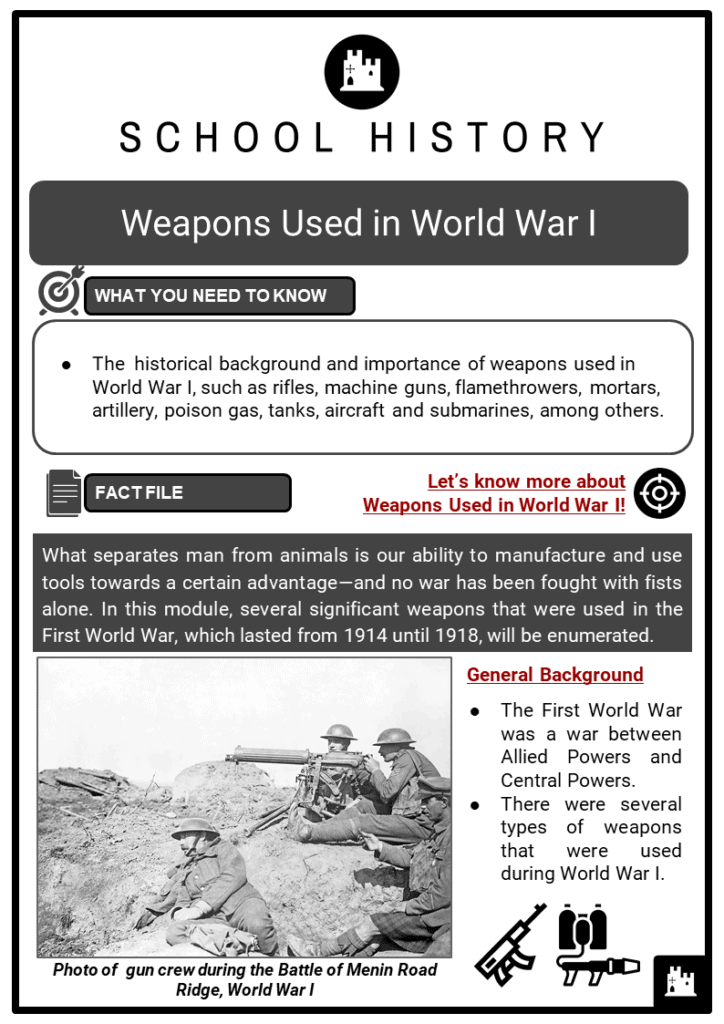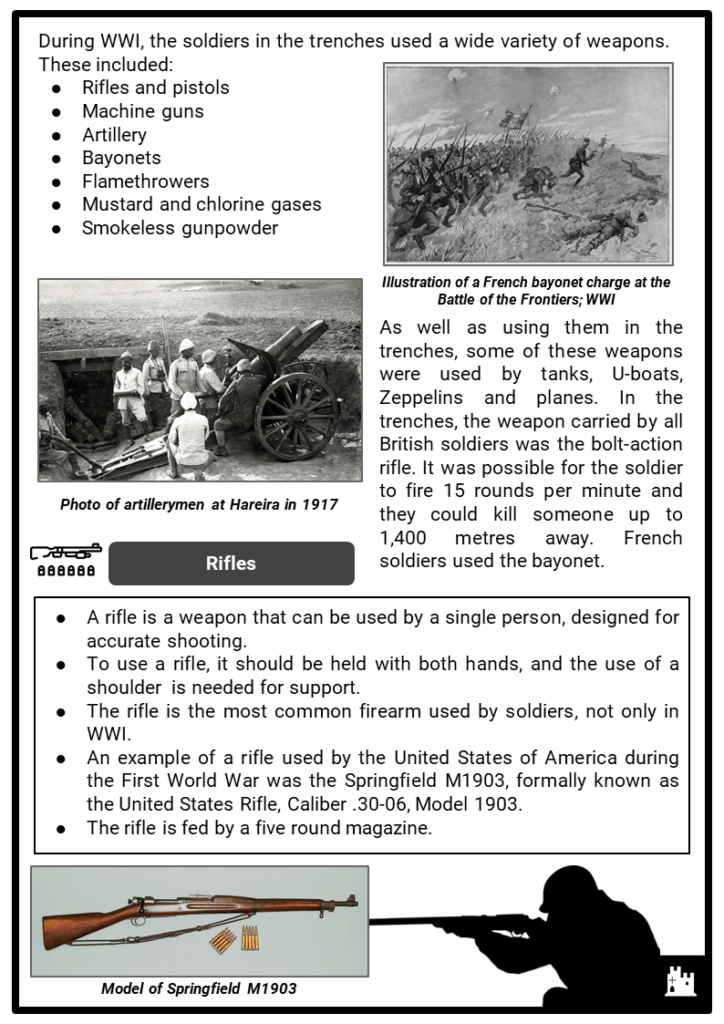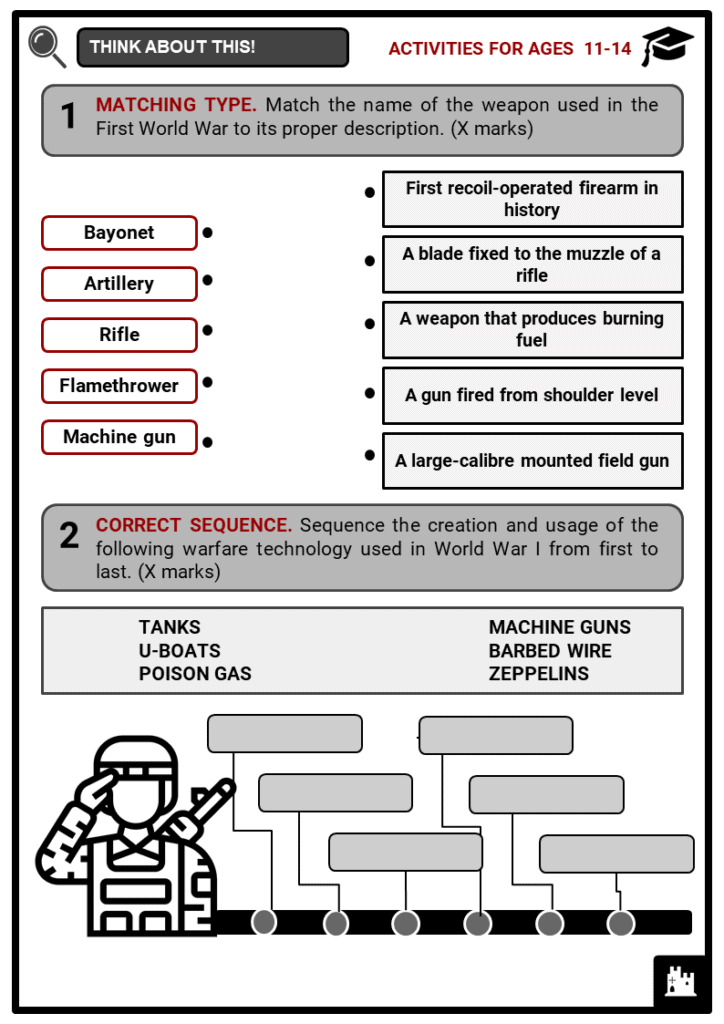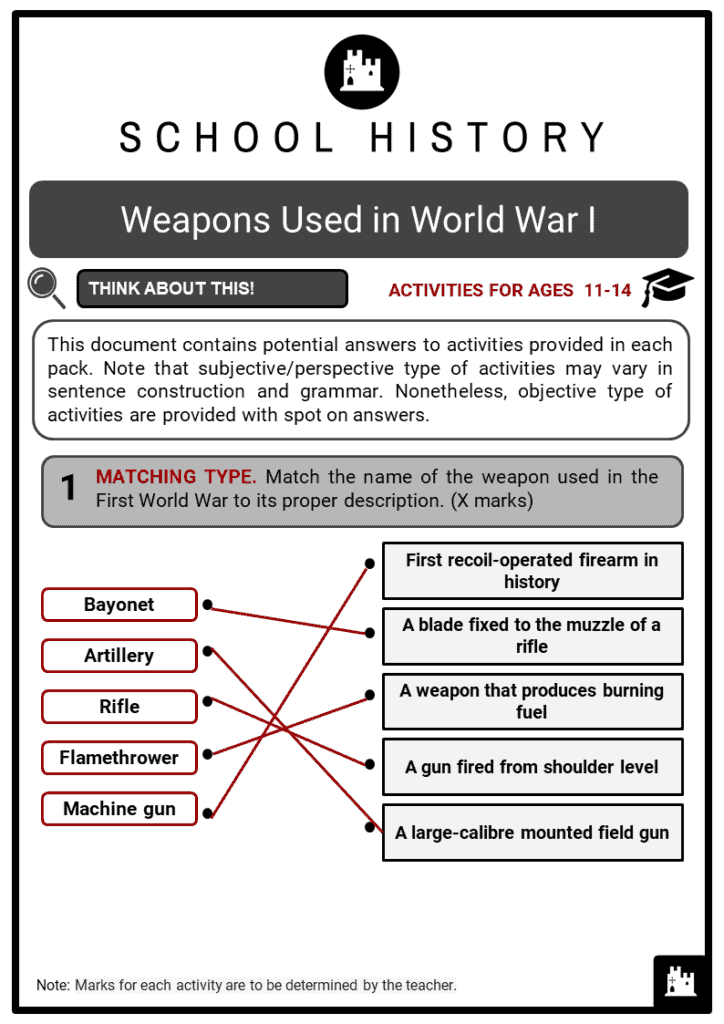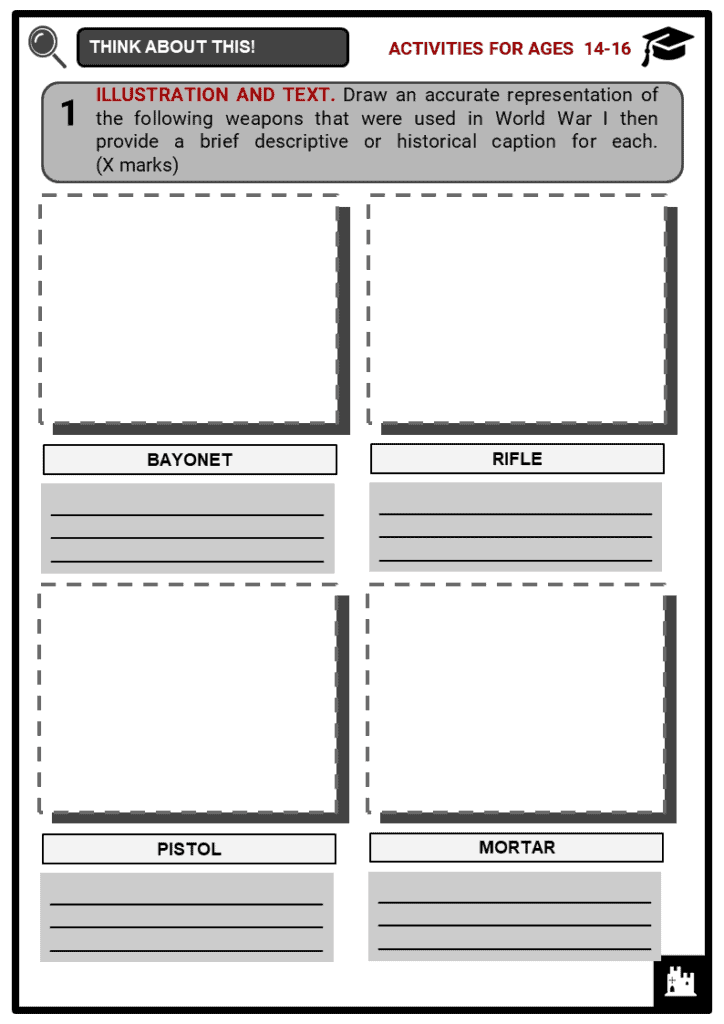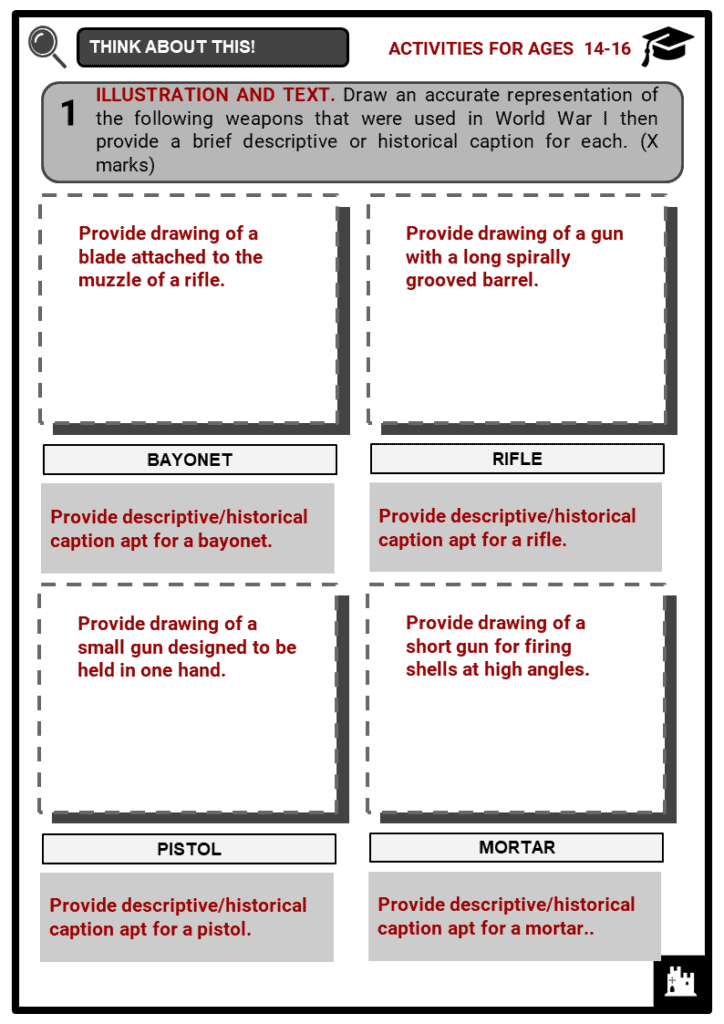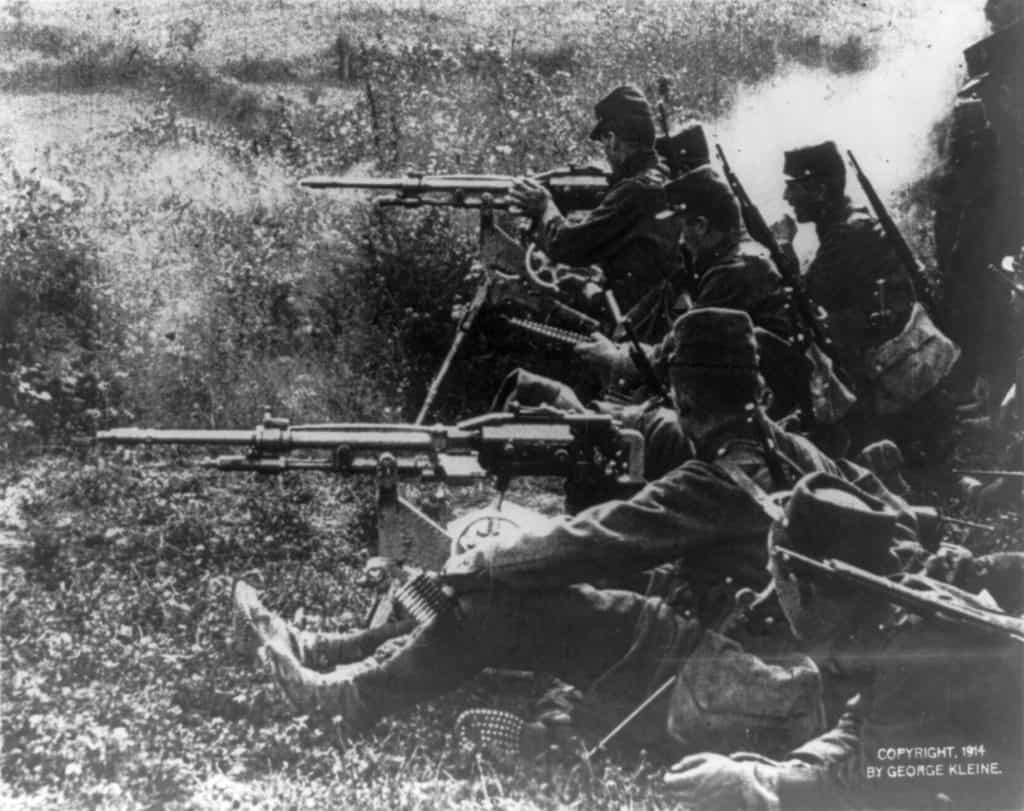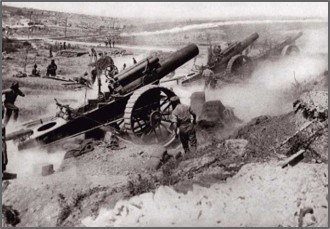Download Weapons Used in World War I Worksheets
Do you want to save dozens of hours in time? Get your evenings and weekends back? Be able to teach Weapons Used in World War I to your students?
Our worksheet bundle includes a fact file and printable worksheets and student activities. Perfect for both the classroom and homeschooling!
Table of Contents
Add a header to begin generating the table of contents
Summary
- The historical background and importance of weapons used in World War I, such as rifles, machine guns, flamethrowers, mortars, artillery, poison gas, tanks, aircraft and submarines, among others.
Key Facts And Information
Let’s know more about Weapons Used in World War I!
- What separates man from animals is our ability to manufacture and use tools towards a certain advantage—and no war has been fought with fists alone. In this module, several significant weapons that were used in the First World War, which lasted from 1914 until 1918, will be enumerated.
General Background
- The First World War was a war between Allied Powers and Central Powers.
- There were several types of weapons that were used during World War I.
- During WWI, the soldiers in the trenches used a wide variety of weapons. These included:
- Rifles and pistols
- Machine guns
- Artillery
- Bayonets
- Flamethrowers
- Mustard and chlorine gases
- Smokeless gunpowder
- As well as using them in the trenches, some of these weapons were used by tanks, U-boats, Zeppelins and planes. In the trenches, the weapon carried by all British soldiers was the bolt-action rifle. It was possible for the soldier to fire 15 rounds per minute and they could kill someone up to 1,400 metres away. French soldiers used the bayonet.
Rifles
- A rifle is a weapon that can be used by a single person, designed for accurate shooting.
- To use a rifle, it should be held with both hands, and the use of a shoulder is needed for support.
- The rifle is the most common firearm used by soldiers, not only in WWI.
- An example of a rifle used by the United States of America during the First World War was the Springfield M1903, formally known as the United States Rifle, Caliber .30-06, Model 1903.
- The rifle is fed by a five round magazine.
Machine Guns
- The machine guns used in World War I followed Sir Hiram Stevens Maxim’s design of 1884, also known as a Maxim Gun.
- It was the first recoil-operated firearms in history.
- It is a gun capable of rapid firing. For example, the Maxim Gun could fire 600 rounds per minute.
- Unlike today, machine guns were not the main weapons of soldiers. They needed 4-6 men to man them in 1914 and had to be positioned on a flat surface. They could fire up to 400 rounds per minute and had the fire power of 100 guns!
Flamethrowers
- As the name indicates it is literally a “firearm” as the person who uses it arms himself the power of fire.
- To provide historical background, attempts to develop a “flame-throwing” device are recorded as early as ancient China, and Southern American newspapers claimed that Abraham Lincoln supervised tests of a flamethrower during the American Civil War.
- The first use of flamethrowers in the First World War happened on February 26, 1915, not by the United States of America, but by German military at the Battle of Malancourt.
Mortars
- Mortars look much like cannons, but shoot smaller shells three inches in length.
- While cannons are usually planted on the ground or dragged with a wheel attachment, mortars are lightweight and portable.
- Basically, a mortar consists of a metal tube fixed to a base plate, and stands on the ground using a lightweight bipod mount.
- Mortars launch bombs high up in the air, so the trajectory of its shells were not so exact. It is used as an indirect fire weapon for close fire support.
- The Stokes Mortar used by the British Empire in 1915 has the capacity to fire up to 22 shells per minute, over the range of 1,200 yards.
- The Germans developed a mortar that has a barrel 10 inches in length, and fired shells loaded with metal balls. It was called the minenwerfer or “mine thrower.”
Artillery
- Artillery is a broad term for a weapon, but it is actually a system of weapon(s).
- it could refer to larger mortars, howitzers, and cannons.
- Artilleries are the weapons that caused most deaths in World War I.
- Giant artillery has massive firing range, it could fire so far that the earth’s rotation should be taken into account when firing.
- A good example of artillery is what the French used during the First World War: a 75 mm cannon dubbed as the “Devil Gun.” The French claim this artillary as their weapon of success.
- Artillery is the word used to describe large-calibre mounted field guns.
- The calibre is the diameter of the barrel.
- The stalemate meant they needed long-range weapons that could deliver devastating blows to the enemy.
- They needed crews of up to 12 men to work them; the shells weighed up to 900 lb (very heavy).
Poison Gas
- Poison Gas was also used in the First World War, unlike bullets which directly shoot through the body, poison gas attacks the enemy's body from the inside when inhaled.
- This war was also the first to use chlorine and mustard gas.
- The German army was the first to use chlorine in 1915 at Ypres.
- Gas attacks in World War I began on April 22, 1915, as the German military fired a shell containing chlorine gas in Ypres.
- Chlorine gas targeted the enemy’s eyes and respiratory system.
- Another gas utilised was mustard gas, that inflicted damages similar to chlorine gas, but causes blistering on exposed skin in addition.
- Poison gas did not cause fatalities like other weapons, but was enough to incapacitate or immobilise a population of enemy troops.
- French soldiers had not come across chlorine gas before and assumed that it was a smoke screen.
- It has a distinctive smell – a mixture of pepper and pineapple – and they only realised they were being gassed when they started to have chest pains and a burning sensation in their throats! Death is painful – you suffocate!
- Afterwards, Allied forces discovered that urine-soaked cotton pads neutralised the chlorine.
- However, they found it difficult to fight like this!
- Mustard gas was the most deadly biological weapon that was used in the trenches.
- Mustard gas was odourless and took 12 hours to take effect.
- It was also very powerful, only small amounts needed to be added to shells to be effective and it remained active for several weeks when it landed in the soil.
- The nastiest thing about mustard gas is that it made the skin blister, the eyes sore and the victim would start to vomit.
- It would cause internal and external bleeding, and would target the lungs. It could take up to 5 weeks to die.
Tanks
- The origin of tanks came from the idea of battleships capable of fighting on land.
- The British Empire secretly developed such a weapon, and it was called a “Tank”. The name stayed on forever.
- The First British tank was called the “Little Willie,” weighing 14 tons and crawling at 3 metres per hour.
- It broke down frequently.
- Improved versions of the British Tank were deployed during the First World War.
- During the First World War, tanks were not trusted due to persistent issues with breaking down.
- After the British Empire, the French Empire also developed their Tank: the Renault FT light armoured vehicle.
- Following France and Britain, Germany developed their A7V tank, a vehicle resembling a one-story building on wheels.
- The first time tanks were used during the First World War was in the Battle of Cambrai, on Nov. 20, 1917.
- The British forces deployed 470 tanks to organise a formation in order to support their infantry.
Aircrafts
- During the First World War, aircrafts were still a newfound technology.
- Aircrafts were initially used for military surveillance until Anton Herman Gerard “Anthony” Fokker, a Dutch aviator, found a way to arm a plane with a machine gun and synchronise its firing with the propeller’s rotation.
- Soon enough in the First World War, Germans were able to develop and deploy the Zeppelin-Staaken R.VI, an aircraft capable of dropping bombs.
- It might be safe to say that war helped in the development of aircraft technology. Here are examples of aircrafts used in the First World War:
- The Bristol Type 22 is a two-seater plane developed by the British Empire.
- The most famous plane during WWI came from the Germans, and it was the Fokker Eindecker, a single-seat fighter plane.
Submarines
- Submarines were used in World War I to attack military ships without being seen, through the use of torpedoes.
- Britain, France, Russia, and the U.S. developed submarine forces earlier than 1906, when Germany developed theirs.
- They were also called Unterzee Boats by the Germans, which means Undersea Boats, or simply U-boats.
- The use of U-boats in WWI were specially linked to the Imperial German Navy, who utilised U-boats to gain strength against the British Royal Navy.
Image sources:

